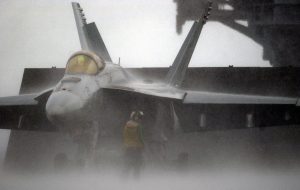
810G covers rain exposure in Method 506.5. This method comprises 11 pages. The purpose of Method 506.5 is to help determine effects of rain, water spray or dripping water:
- The effectiveness of protective covers, cases, and seals in preventing the penetration of water into the materiel.
- The capability of the materiel to satisfy its performance requirements during and after exposure to water.
- Any physical deterioration of the materiel caused by the rain.
- The effectiveness of any water removal system.
- The effectiveness of protection offered to a packaged materiel.
Method 512.5 covers immersion and is considered a more stringent test than 506.5. If the material configuration is the same as when tested for 512.5, 506.5 testing is redundant.
Limitations to this section include:
- The method is not intended to examine rain erosion effects such as radomes, helicopter blade leading edges, etc.
- It may be difficult to determine rain effects on electromagnetic radiation and propagation because of the size of the required facility.
- Determining adequacy of aircraft windshield rain removal.
- Does not address pressure washers or decontamination devices.
- Effects of extended periods of exposure to rain or light condensation drip rates caused by an overhead surface with pooling water.
Method 506.5 provides three procedures:
- Procedure I – Rain and blowing rain. Applicable to material that will be deployed out-of-doors.
- Procedure II – Exaggerated. For use for large objects that may not fit in a chamber. Uses water spray under pressure from a nozzle.
- Procedure III – Drip. Appropriate when material is normally protected from rain but may be exposed to falling water from upper surfaces.
As with all of Mil-Std-810G, the test methods are intended to simulate real world conditions. For example, it may be advantageous to start the test with the tested item warmer (10°C) than the “rain”. The “rain” will cause a lower temperature and subsequent lower pressure within the tested equipment which may draw in water revealing a possible failure point.
While rainfall rates around the world vary, and it may be appropriate to mimic those higher rates, in general, a rate of 4 in/hr is not an uncommon occurrence and will provide a reasonable degree of confidence.
Wind is also a factor and provision should be made to provide a simulated velocity of at least 40mph. Higher velocities may be appropriate depending on the intended environment. The item under test should be oriented to maximize potential rain penetration.
For Procedure I (rain and blowing rain), the test duration should be at least 30 minutes per surface. Rotate the item under test for each surface to be exposed to the wind.
CP Technologies has engineered and produced rugged enclosures for exterior environments.
By David Lippincott CP Technologies cpnorthamerica.com
